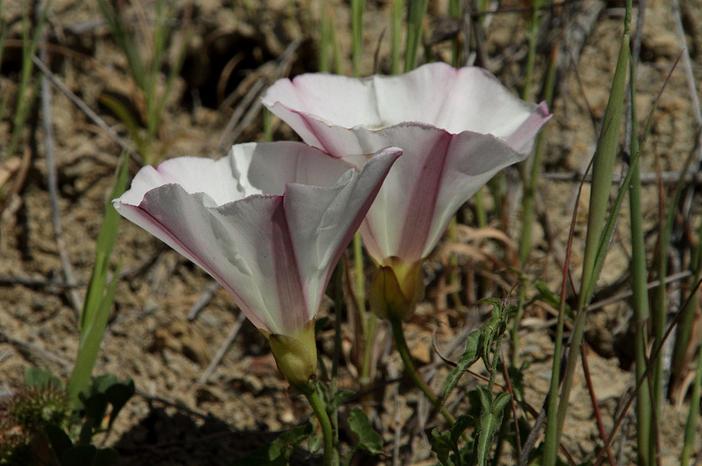Island False Bindweed
(Calystegia macrostegia subsp. cyclostegia)
Island False Bindweed (Calystegia macrostegia subsp. cyclostegia)
/
/

NatureShutterbug
CC BY 2.0
Image By:
NatureShutterbug
Recorded By:
Copyright:
CC BY 2.0
Copyright Notice:
Photo by: NatureShutterbug | License Type: CC BY 2.0 | License URL: https://creativecommons.org/licenses/by/2.0/ | Uploader: NatureShutterbug | Publisher: Flickr


















Estimated Native Range
Summary
Calystegia macrostegia subsp. cyclostegia, commonly known as Island False Bindweed or Island Morning Glory, is a perennial vine native to coastal regions of Central and Southern California. It thrives in a variety of habitats including coastal sage scrub, chaparral, and southern oak woodland. This plant exhibits a moderate growth rate and can reach a height of 1-10 feet (0.3-3 meters) with a spread of 3-6 feet (0.9-1.8 meters). Its twining stems are covered with lush, heart-shaped leaves, and it produces large, trumpet-shaped flowers that are typically white or pink, blooming profusely in the spring and summer months. The flowers are quite showy and attract pollinators such as bees and hummingbirds.
Island False Bindweed is valued for its ornamental flowers and its ability to cover unsightly areas, making it a popular choice for trellises, fences, and as a ground cover in gardens. It is drought-tolerant once established, requiring low to medium amounts of water, and it adapts well to a range of soil types, including clay, loam, and sandy soils, provided they have medium to fast drainage. While it prefers full sun to part shade, it is also tolerant of coastal conditions. Gardeners should be aware that it can become aggressive in favorable conditions and may require regular pruning to keep it in check. It is not typically associated with serious diseases or pests, but it can outcompete other plants if not managed properly.CC BY-SA 4.0
Island False Bindweed is valued for its ornamental flowers and its ability to cover unsightly areas, making it a popular choice for trellises, fences, and as a ground cover in gardens. It is drought-tolerant once established, requiring low to medium amounts of water, and it adapts well to a range of soil types, including clay, loam, and sandy soils, provided they have medium to fast drainage. While it prefers full sun to part shade, it is also tolerant of coastal conditions. Gardeners should be aware that it can become aggressive in favorable conditions and may require regular pruning to keep it in check. It is not typically associated with serious diseases or pests, but it can outcompete other plants if not managed properly.CC BY-SA 4.0
Plant Description
- Plant Type: Vine
- Height: 1-10 feet
- Width: 3-6 feet
- Growth Rate: Moderate
- Flower Color: White, Pink
- Flowering Season: Spring, Summer
- Leaf Retention: Deciduous
Growth Requirements
- Sun: Full Sun, Part Shade
- Water: Low, Medium
- Drainage: Medium, Fast
Common Uses
Bee Garden, Border Plant, Butterfly Garden, Drought Tolerant, Low Maintenance, Showy Flowers
Natural Habitat
native to coastal regions of Central and Southern California in coastal sage scrub, chaparral, and southern oak woodland environments
Other Names
Common Names: Island Morning Glory
Scientific Names: , Calystegia macrostegia subsp. cyclostegia, Convolvulus cyclostegius, Convolvulus greenei, Convolvulus nuttallii, Convolvulus occidentalis var. cyclostegius, Convolvulus occidentalis var. tenuissimus,
GBIF Accepted Name: